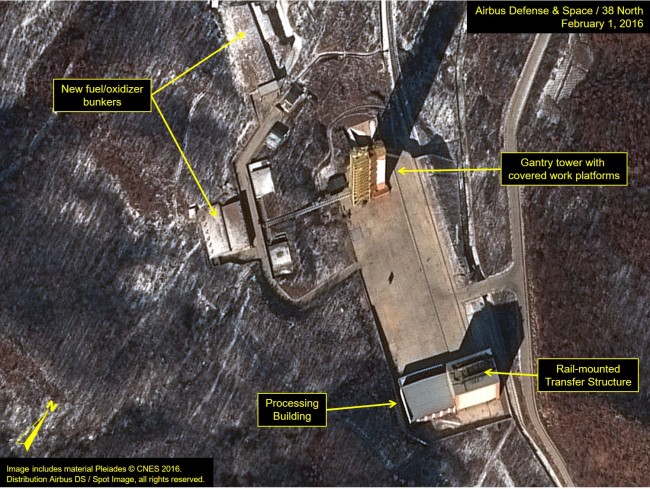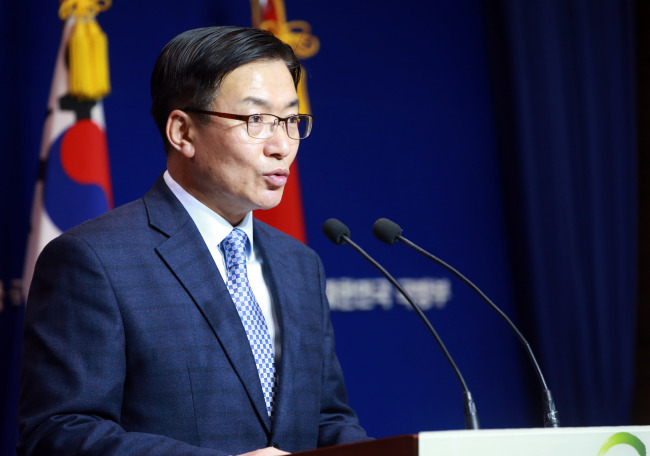Seoul will intercept if North Korean missile falls in its territory: ministry
By KH디지털2Published : Feb. 4, 2016 - 16:06
With North Korea gearing up for a fresh long-range missile test, South Korea is stepping up its capabilities to intercept any incoming rocket or its parts within its territory and take “due” retaliatory measures in self-defense, the Defense Ministry said Thursday.
President Park Geun-hye once again urged Pyongyang to shelve its professed plans to fire what it claims to be an Earth-monitoring satellite between Feb. 8 and 25, stressing any launch entailing ballistic missile technology would be a “direct challenge” to and a “clear violation” of international resolutions.
While intensifying monitoring activities in partnership with the U.S., Seoul said it has completed the deployment of assets to identify and track a missile when it actually takes off, such as the Patriot Advanced Capability-2 interception system.
“We’re strengthening our air defense operations readiness posture so as to intercept a missile or part of its wreckage should it fall in our territory, and will take corresponding self-defense steps according to the range and the extent of damage,” Defense Ministry spokesman Moon Sang-gyun told reporters.
U.S. Defense Secretary Ash Carter also reportedly said during a trip to the Marine Corps air station in Miramar, California, that the country continues to shore up its defense against a possible North Korean missile attack. But he added that he has no plan to further expand Washington’s ongoing program to raise the number of ground-based missile interceptors in Alaska and Hawaii to 44 from 30 and upgrade them.
President Park Geun-hye once again urged Pyongyang to shelve its professed plans to fire what it claims to be an Earth-monitoring satellite between Feb. 8 and 25, stressing any launch entailing ballistic missile technology would be a “direct challenge” to and a “clear violation” of international resolutions.
While intensifying monitoring activities in partnership with the U.S., Seoul said it has completed the deployment of assets to identify and track a missile when it actually takes off, such as the Patriot Advanced Capability-2 interception system.
“We’re strengthening our air defense operations readiness posture so as to intercept a missile or part of its wreckage should it fall in our territory, and will take corresponding self-defense steps according to the range and the extent of damage,” Defense Ministry spokesman Moon Sang-gyun told reporters.
U.S. Defense Secretary Ash Carter also reportedly said during a trip to the Marine Corps air station in Miramar, California, that the country continues to shore up its defense against a possible North Korean missile attack. But he added that he has no plan to further expand Washington’s ongoing program to raise the number of ground-based missile interceptors in Alaska and Hawaii to 44 from 30 and upgrade them.

An increase in vehicles and equipment installation has been detected at a missile station in the North’s northwest, pointing to progress in its preparations for the launch, the U.S.-Korea Institute at Johns Hopkins School of Advanced International Studies said Wednesday on its 38 North website, citing commercial satellite photos taken on Feb. 1.
In particular, nine vehicles were spotted, compared with only one a week ago, at the Horizontal Processing Building that has been used to receive various rocket stages in past rocket liftoffs.
“Once received, they are assembled in the horizontal position to test all connections, perform final testing of subsystems and prepare the stages for mounting on the launchpad,” the blog said, adding that the level of activity is similar to what was seen in the lead-up to the last launch in 2012.

Though Moon declined to comment on the perceived preparations at the Dongchang-ri site, other military officials forecast that Pyongyang would most likely fire the missile between Feb. 10 and 12, citing the significance of weather conditions for the event’s success and the predicted snow on Feb. 8-9.
The unveiled time frame is deemed designed to coincide with the Feb. 16 birthday of Kim Jong-il, current leader Kim Jong-un’s late father and longtime strongman, given the regime’s longstanding tradition of staging provocations around major anniversaries.
“The precise date is to be seen, but the North may think it would be able to maximize the launch’s impact shortly after the Feb. 8-9 Lunar New Year holidays. With the climate conditions taken into account, it has little to gain by dragging it out,” a military official said on customary condition of anonymity.
Later that day, the Northwest Islands Defense Command under the Joint Chiefs of Staff conducted a large-scale firing drill near the border islets in the West Sea, participated in by some 1,000 troops, 40 K-9 self-propelled howitzers, tanks, Korea Amphibious Assault Vehicles, Cobra attack helicopters and other devices.
The Navy also carried out antisubmarine, ship and aircraft exercises in the East and West Seas, involving some 20 warships led by the 3,200-ton destroyer Gwanggaeto the Great, a submarine and about 10 aircraft including P-3C Orion patrol planes, Lynx antisubmarine helicopters and KF-16 warplanes.
The simultaneous exercises were intended to send a warning to Pyongyang against potential regional military provocations aside from the missile experiment.
Over the last couple of months, the North has installed new firing positions on Galdo Island, where it has stationed 122-millimeter howitzers, multiple rocket launchers and monitoring gear since the two Koreas traded fire last August, according to the JCS. The island is some 2.5 kilometers north of the Northern Limit Line, the de facto naval frontier in the West Sea. The regime has also built additional monitoring equipment on Arido Island, another uninhabited island about 12 kilometers northeast of the South’s Yeonpyeongdo Island.
A North Korean mobile missile launcher carrying a ballistic missile has been identified moving toward the east coast, Japanese public broadcaster NHK said earlier in the day, but spokesman Moon said the ministry could not confirm the report.
The U.S., for its part, has recently dispatched its Special Operations Forces here for joint training with South Korea’s Special Warfare Command, the U.S. Forces Korea said Wednesday. The visiting personnel are part of the 1st Special Forces Group and the 75th Ranger Regiment.
Though the USFK said the team's stationing is rotational, its rare unveiling appeared to be aimed at ratcheting up pressure on Pyongyang, given the elite commandos’ famed sniping and other operations on such battlefields as Iraq and Afghanistan and role in deterring regional asymmetric aggression.
“If North Korea pushes ahead with the long-range missile launch, I warn that it will have to pay a severe price for posing a grave threat to peace and security of not only the peninsula, but also the region and the world,” Park was quoted as saying by chief presidential press secretary Kim Sung-woo.
Meanwhile, skepticism is boiling over Beijing’s clout in bringing its defiant neighbor under control, and ensuing its persistent diplomatic and economic shield that critics have long pointed to as a major snag in global efforts to denuclearize North Korea through isolation and sanctions.
The North’s declaration of its launch plan came amid a surprise three-day visit to Pyongyang by Wu Dawei, China’s special representative for Korean affairs and top nuclear negotiator, who Seoul officials suspected had also not anticipated it.
China’s Foreign Ministry spokesman Lu Kang, who downplayed the country’s influence in North Korean affairs a day earlier, said Wu had met with Foreign Minister Ri Su-yong, Vice Foreign Minister Kim Kye-kwan and his counterpart Ri Yong-ho during his stay.
Upon arrival at the Beijing international airport late Thursday, Wu simply told reporters that he was unsure what the regime’s next move would be, while indicating that he had conveyed China’s opposition to further provocations. “I said what must be said. I did what must be done. … But on what the outcome will be, I don’t know yet,” he was quoted as saying by Japan’s Kyodo News.
Asked on Wu’s trip, Seoul’s Foreign Ministry spokesman Cho June-hyuck refused to confirm any details, saying the two nations remain “in close consultation” over its results.
By Shin Hyon-hee (heeshin@heraldcorp.com)


















![[Today’s K-pop] Treasure to publish magazine for debut anniversary](http://res.heraldm.com/phpwas/restmb_idxmake.php?idx=642&simg=/content/image/2024/07/26/20240726050551_0.jpg&u=)